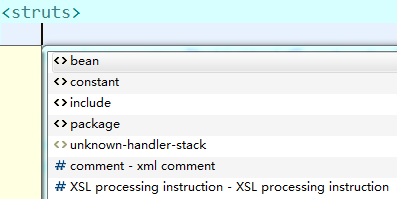
1.bean
Bean详细讲解:https://www.cnblogs.com/lulu638/p/4340703.html
2.constant
constant属性配置,可配置的属性可以参考default.properties(在struts2-core-2.3.24.jar包/org/apache/struts2/default.properties)
1 <struts> 2 <!-- 乱码解决 --> 3 <constant name="struts.i18n.encoding" value="UTF-8"></constant> 4 <!-- 自定义拓展名 --> 5 <constant name="struts.action.extension" value="action,,ahd"></constant> 6 <!--设置开发模式,使显示的界面更加友好--> 7 <constant name="struts.devMode" value="true"></constant>> 8 <!--设置配置文件修改后自动加载,仅推荐在开发中使用--> 9 <constant name="struts.configuration.xml.reload" value="true"></constant> 10 </struts>
3.include
struts.xml文件使用include标签可以包含其他xml文件内容,适合团队协作,每人做自己的部分,最后在struts.xml文件中使用include标签包含其他人的配置文件
<include file="com/ahd/strutsXml/hello.xml"></include>
4.package
Struts2使用包来组织Action,将Action放在包下来定义,通过package元素配置一个包,通过package的子元素action来定义一个Action;
Struts2框架中核心组件就是Action、拦截器等,Struts2使用包来管理Action和拦截器等。每个包就是多个Action、拦截器引用的集合。
<package name="login" extends="struts-default" namespace="/"> <action name="login" class="com.ahd.action.LoginAction"> <result name="success">/hello.jsp</result> </action> </package>
name属性:包package必须指定name值,作为引用该包的唯一标识
extends:可选属性,指定子包可以继承一个或多个父包的Action和拦截器等配置, 指定package继承另一package的所有配置。通常情况下,我们使用struts-default作为package的基础。,一般默认继承struts的默认文件:struts-defaule.xml配置文件,继承多个父包时用”,”隔开.
namespace:可选属性, Actions的唯一命名空间,定义带包的命名空间,默认是””,处理时 命名空间/actionName
abstract:可选属性,指定该包是否是一个抽象包, 定义package为抽象的。如果标记为true,则package不能被最终用户使用。
action元素:
name属性:必须属性,用来配置action的url
class属性:非必须属性,可有可无,有则配置上action实现类的完整类名,没有则struts框架会根据name属性自动匹配action实现类
method属性:用来指定调用action实现类的哪个方法,如果没有配置该属性,该属性默认为action实现类的execute方法.
convert属性:非必须属性,应用于action的类型转换的完整类名